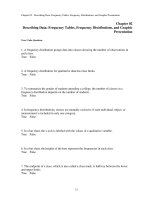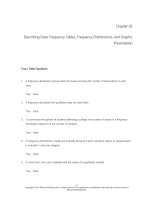Lecture Statistical techniques in business and economics - Chapter 3: Describing Data: measures of central tendency
Bạn đang xem bản rút gọn của tài liệu. Xem và tải ngay bản đầy đủ của tài liệu tại đây (2.77 MB, 58 trang )
3 1
Copyright © 2004 by The McGrawHill Companies, Inc. All rights reserved.
3 2
When you have completed this chapter, you will be able to:
1.
Calculate the arithmetic mean, the weighted mean, the median,
the mode, and the geometric mean of a given data set.
2.
Identify the relative positions of the arithmetic mean, median
and mode for both symmetric and skewed distributions.
3.
Point out the proper uses and common misuses of each
measure.
4.
Explain your choice of the measure of central tendency of
data.
5.
Explain the result of your analysis.
Copyright © 2004 by The McGrawHill Companies, Inc. All rights reserved.
Five Measures of
Measures of
Five
Central
Central
Tendency
Tendency
arithmetic mean
mode
median
weighted mean
Average price of a house in
Average price of a house in
Ottawa (2000) was $126 000
Ottawa (2000) was $126 000
The average income of two
The average income of two
parent families with children in
parent families with children in
Canada was $65,847 in 1995 and
Canada was $65,847 in 1995 and
$72,910 in 1999. (StatCan)
(StatCan)
$72,910 in 1999.
Copyright © 2004 by The McGrawHill Companies, Inc. All rights reserved.
3 3
geometric mean
The average price of a
The average price of a
house in Toronto in 1996
house in Toronto in 1996
was $238,511 (StatCan)
(StatCan)
was $238,511
My grade point average
My grade point average
for last semester was 4.0
for last semester was 4.0
Arithmetic Mean
Arithmetic Mean
3 4
…is the most widely used measure of location.
…is the most widely used measure of location.
It is calculated by summing the values and
dividing by the number of values
It requires the interval scale
All values are used
It is unique
The sum of the deviations from the mean is 0
Copyright © 2004 by The McGrawHill Companies, Inc. All rights reserved.
Population Mean
Population Mean
Formula
Formula
x
µ =
N
… is the population mean
(pronounced mu)
N
… is the total number of observations
x
… is a particular value
… indicates the operation of adding
(sigma)
Copyright © 2004 by The McGrawHill Companies, Inc. All rights reserved.
3 5
Terminology
Parameter
…is a measurable characteristic of a
is a measurable characteristic of a
…
opulation
PPopulation
Statistic
…is a measurable characteristic of a
is a measurable characteristic of a
…
Sample
Sample
Copyright © 2004 by The McGrawHill Companies, Inc. All rights reserved.
3 6
Population Mean
Population Mean
Formula
Formula
The Kiers family
The Kiers family
3 7
x
µ =
N
owns four cars.
Find the mean
owns four cars.
Find the mean
mileage for the cars.
The following is
mileage for the cars.
The following is
the current mileage
the current mileage
on each of the four
on each of the four
56000 + 23000 + 42000 + 73000
cars:
56000 + 23000 + 42000 + 73000
cars:
= 4
56,000 23,000 4
42,000 73,000
Copyright © 2004 by The McGrawHill Companies, Inc. All rights reserved.
48 500
== 48 500
Sample Mean
Sample Mean
Formula
Formula
x
x =
3 8
x
n
…is the sample mean (read “x bar”)
n
… is the number of sample observations
x
… is a particular value
… indicates the operation of adding
(sigma)
Copyright © 2004 by The McGrawHill Companies, Inc. All rights reserved.
3 9
A sample of five executives received the
following bonuses last year ($000):
14.0 15.0 17.0 16.0 15.0
Determine the average bonus given last year:
Formula
Formula
x =
x
n
14 + 15 + 17 + 16 + 15
14 + 15 + 17 + 16 + 15
= 5
5
77 / 5 == 15.4
15.4
== 77 / 5
The average bonus given last year was $15 400
The average bonus given last year was $15 400
Copyright © 2004 by The McGrawHill Companies, Inc. All rights reserved.
Properties of an
of an
Properties
3 10
Arithmetic Mean
Arithmetic Mean
…Every set of intervallevel and ratio
level data has a mean
… All the values are included in
computing the mean
…A set of data has a unique mean
…The mean is affected by unusually
large or small data values
…The arithmetic mean is the
only measure of central
tendency where
the sum of the deviations
Copyright © 2004 by The McGrawHill Companies, Inc. All rights reserved.
Arithmetic Mean
Arithmetic Mean
as a Balance Point
as a Balance Point
3 11
Illustrate the mean of the values 3, 8 and 4.
15 / 3 == 5
5
== 15 / 3
Copyright © 2004 by The McGrawHill Companies, Inc. All rights reserved.
3 12
Determining
259
the Mean
3
1
1
in Excel
Copyright © 2004 by The McGrawHill Companies, Inc. All rights reserved.
Using
3 13
ls
o
o
T
n
o
k
c
i
l
C
See
See
Click on DATA
Click on DATA
ANALYSIS
ANALYSIS
See…
Copyright © 2004 by The McGrawHill Companies, Inc. All rights reserved.
Using
3 14
See
See
Highlight DESCRIPTIVE STATISTICS
…Click OK
See…
Copyright © 2004 by The McGrawHill Companies, Inc. All rights reserved.
Using
3 15
Cl
See
See
K
O
n
o
k
ic
INPUT NEEDS
INPUT NEEDS
A3:A42
See…
Copyright © 2004 by The McGrawHill Companies, Inc. All rights reserved.
See Solution
See Solution
Using
Copyright © 2004 by The McGrawHill Companies, Inc. All rights reserved.
3 16
Alternate solution…
Using
3 17
CLICK ON
CLICK ON
CLICK ON PASTE FUCTION
PASTE FUCTION
CLICK ON
See
See
See…
Copyright © 2004 by The McGrawHill Companies, Inc. All rights reserved.
Using
3 18
SCROLL DOWN TO STATISTICAL
SCROLL DOWN TO STATISTICAL
See…
Copyright © 2004 by The McGrawHill Companies, Inc. All rights reserved.
Using
3 19
HIGHLIGHT AVERAGE IN RIGHT MENU
HIGHLIGHT AVERAGE IN RIGHT MENU
See
See
K
O
n
o
k
c
i
l
C
See…
Copyright © 2004 by The McGrawHill Companies, Inc. All rights reserved.
See
See
Using
3 20
The mean (average) is placed
in the cell on the worksheet
where your
cursor was when you began.
Copyright © 2004 by The McGrawHill Companies, Inc. All rights reserved.
Weighted Mean
Weighted Mean
3 21
The weighted mean of a set of numbers
The weighted mean of a set of numbers
x
, x
, ... x
,
1
2
n
x1, x2, ... xn,
with corresponding
with corresponding
weights w, w
1, w, ...,w
2, ...,w, is
n, is
weights w
1
2
n
computed from the following formula:
computed from the following formula:
w1 x1 + w2 x2 + ... + wn xn
µw =
w1 + w2 + w3 + ... + wn xn
Copyright © 2004 by The McGrawHill Companies, Inc. All rights reserved.
3 22
During a one hour period on a hot Saturday
afternoon cabana boy Chris served fifty drinks.
He sold:
…five drinks for $0.50
…fifteen for $0.75
…fifteen for $0.90
…fifteen for $1.10
Compute:
the weighted mean of the price of the drinks
μw
5($0.50) 15($0.75) 15($0.90) 15($1.15)
5 15 15 15
$44.50
$ 0 . 89
50
Copyright © 2004 by The McGrawHill Companies, Inc. All rights reserved.
The
Median
The Median
3 23
The Median is the midpoint of the
The Median is the midpoint of the
values after they have been ordered
values after they have been ordered
from the smallest to the largest
from the smallest to the largest
There are as many values
There are as many values
above the median as below it in the data
above the median as below it in the data
array
array
For an even set of values,
For an even set of values,
the
the
median will be the
median will be the
Copyright © 2004 by The McGrawHill Companies, Inc. All rights reserved.
3 24
The ages for a sample of five college students are:
21, 25, 19, 20, 22
Arranging the data in ascending order gives:
19, 20, 21, 22, 25
Thus the median is 21
The heights of four basketball players, in inches, are:
76, 73, 80, 75
Arranging the data in ascending order gives:
73, 75, 76, 80
Thus the median is 75.5
Copyright © 2004 by The McGrawHill Companies, Inc. All rights reserved.
Properties of the Median
Properties of the Median
3 25
There is a unique median for each data set
It is not affected by extremely large or small
values and is therefore a valuable measure of
central tendency when such values occur
It can be computed for ratiolevel,
intervallevel, and ordinallevel data
It can be computed for an
openended frequency distribution
if the median
does not lie in an
openended class
Copyright © 2004 by The McGrawHill Companies, Inc. All rights reserved.









